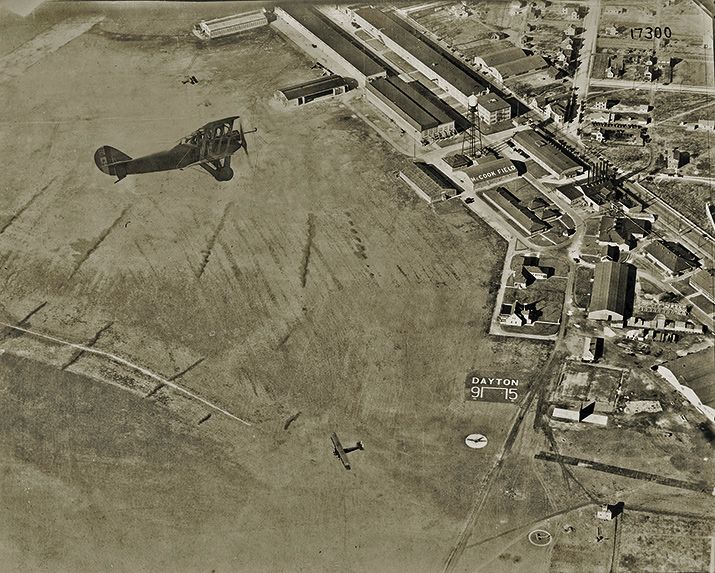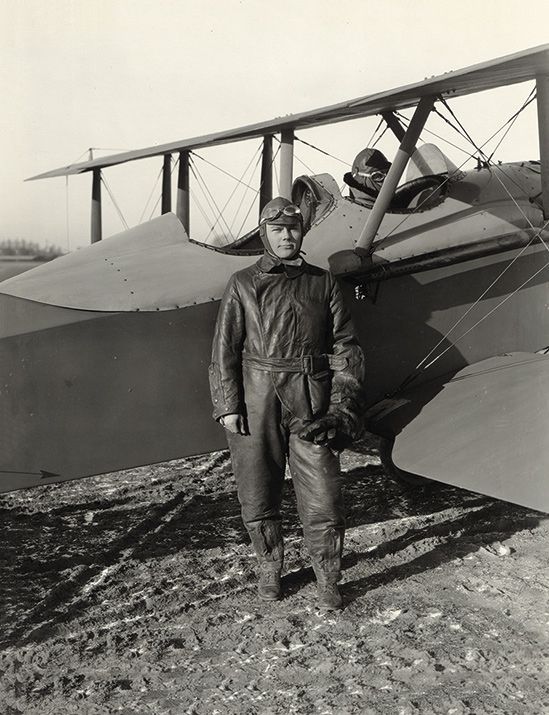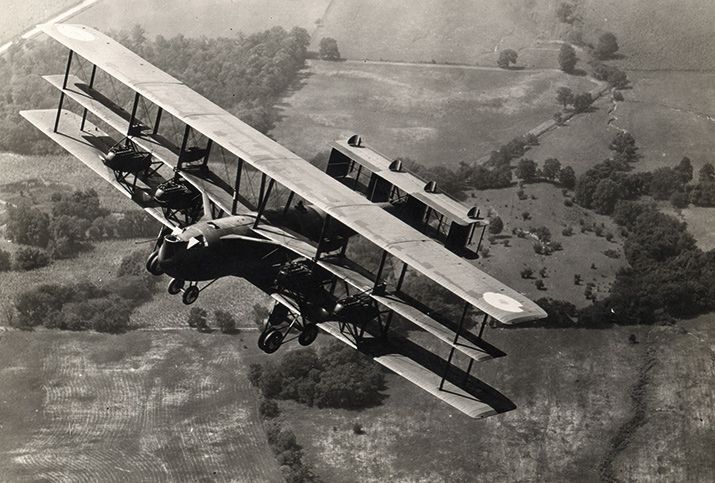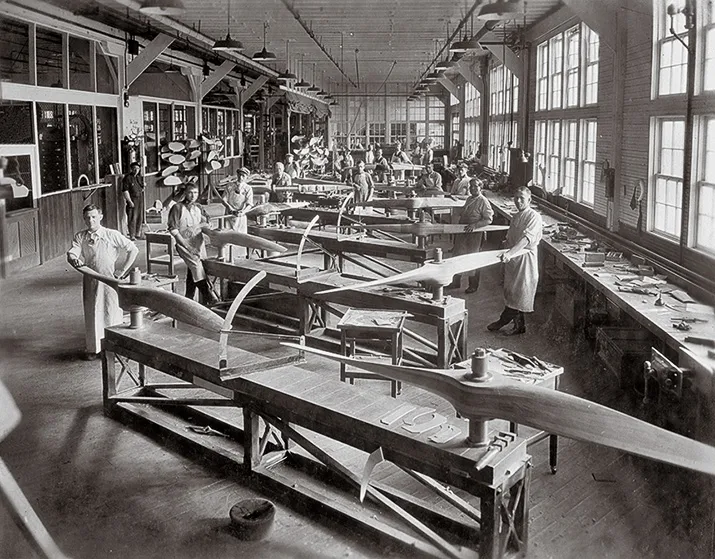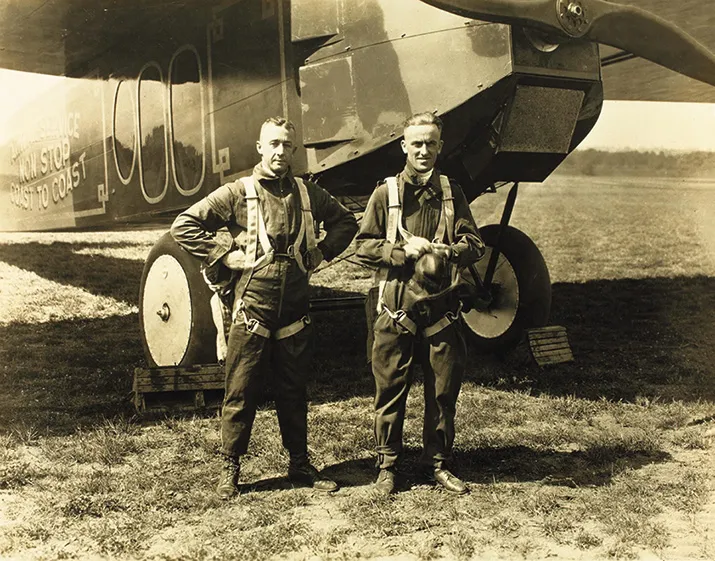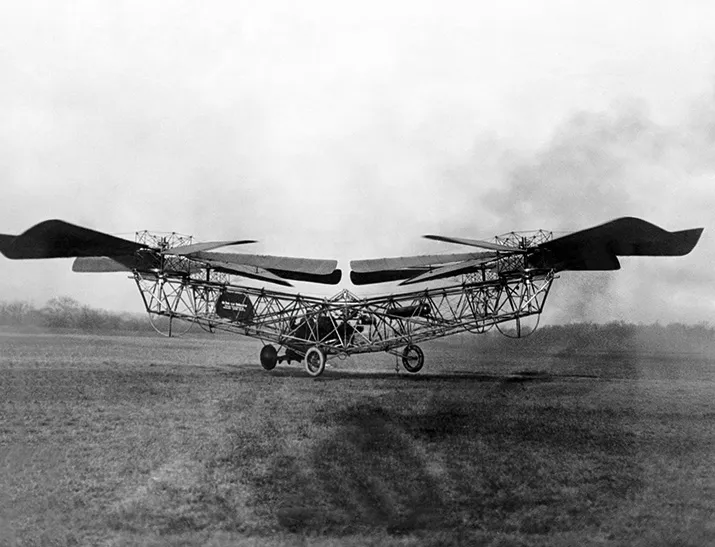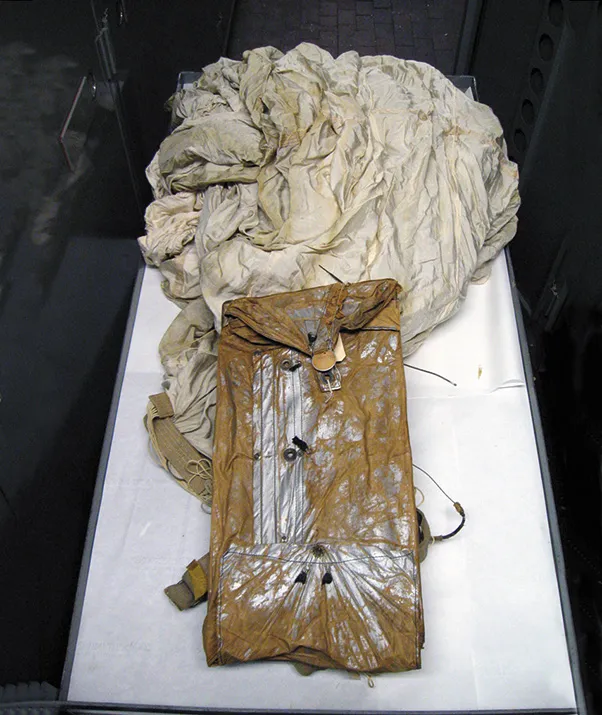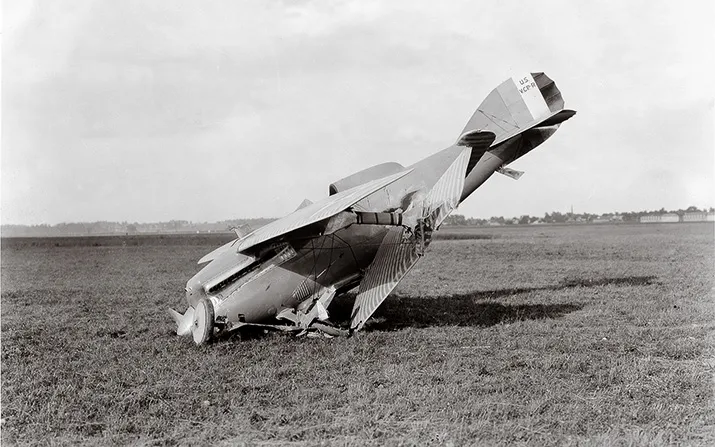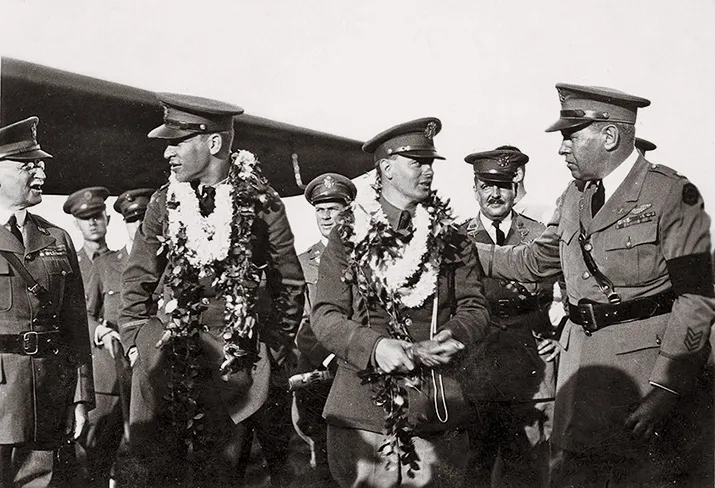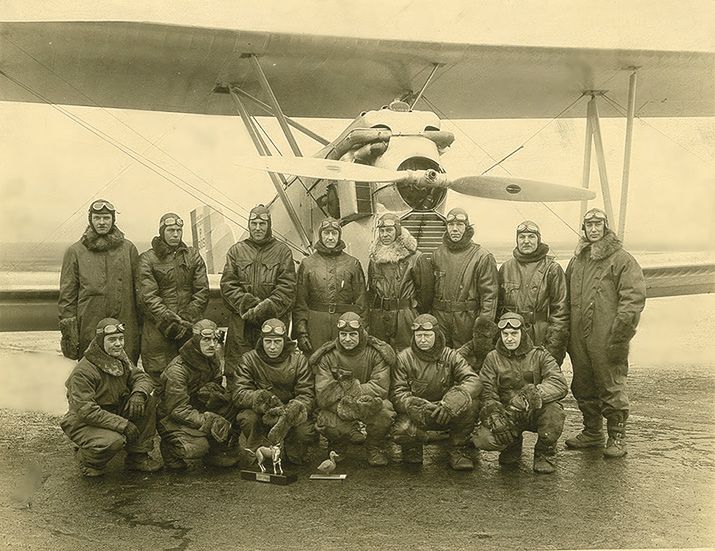The First Test Pilots
At old McCook Field, the art of flying became a science.
/https://tf-cmsv2-smithsonianmag-media.s3.amazonaws.com/filer/96/9e/969ec4e4-eca7-4179-8f51-dd8abfab7844/mccook-test-pilots-1100.jpg)
Not long after ex-World War I aviator John Macready left his California ranch at the age of 54 to serve again in World War II, he was checked out in one of the B-17 bombers he’d soon be flying over North Africa. A young lieutenant, eager to tout the modern, high-altitude capability of the Flying Fortress, pointed out the supercharger that made such missions possible. “Know anything about these, sir?” he asked the veteran of the Great War. Today, Sally Macready Wallace chuckles at the irony: “Daddy just looked at him and said, ‘Yes Lieutenant, I believe I do.’ ”
Twenty years earlier, as chief test pilot at McCook Field in Dayton, Ohio, John Macready had stunned the aviation world by flying a biplane fitted with the world’s first operational supercharger to an astonishing altitude of 34,500 feet. At one point during the flight, nearly seven miles up, it was so cold in the open cockpit that the pilot’s oxygen tube clogged with ice from his own breath. Just another day’s work at America’s first flight laboratory.
Variable-pitch propellers. Guided missiles. An operational rotorcraft 10 years before Sikorsky. Landing lights and radio navigation. The first nonstop transcontinental flight. The Gerhardt Cycleplane, which collapsed in a heap. Around the world in an airplane—before anyone else. Higher, faster, farther.
Part Skunk Works and part research center, the R&D operation at McCook Field was the launch pad for much of 20th century aviation technology. More than 2,300 people worked there during the Roaring Twenties, in 70 buildings housing everything from wind tunnels to machine shops to offices. From 1917 to 1927, every pilot at McCook knew that his next experimental flight might represent a significant leap into aviation’s brave, bold future—and that when he landed, the guy shaking his hand might be Orville Wright.
The Wright brothers, though, were ancient history. Aviation may have been born in Dayton, but by the start of World War I, America’s early edge in flight had already slipped away. In 1912, the French had come to Chicago and walked away with the Gordon Bennett Trophy, after Jules Védrines piloted his Deperdussin racing monoplane at more than 100 mph. “No American competitor even flew against them,” says former Air Force historian Richard Hallion.
On the day in 1917 when the United States entered the war, the total U.S. inventory of military aircraft numbered less than 250, and all were trainers or observation platforms. Commercial aircraft production lagged. Assumptions that airplane development would grow out of the burgeoning auto industry proved unfounded. “Aircraft production at the time of the first world war was more akin to building pianos,” Hallion says. By the Armistice, the sole American-built airplane to see combat—the Dayton Wright Airplane Company’s de Havilland DH.4—was actually designed Over There, constructed to British blueprints.
While war in Europe raged without American airplanes, the U.S. government fast-tracked the establishment of an Army Signal Corps aviation research and development facility in Dayton. The project was assigned national defense priority, and crews worked overtime building wooden hangars, test facilities, classrooms, and barracks. Occupying 250 acres adjacent to the business district, McCook Field—named for the Fighting McCooks, a family of Civil War heroes who owned the property—was the most urban airfield in the nation.
McCook’s engineering division was charged with developing the technology to recapture American aviation’s lost mojo. Though the base was run by the Signal Corps, most of the engineers and designers were civilians, and the vibe was only quasi-military. Army red tape was minimized; Colonel Thurman Bane, commandant in the early years, believed a good idea took precedence over rank. The tempestuous Brigadier General Billy Mitchell, then chief of training and operations for the Air Service in Washington, butted heads with a military establishment he accused of preparing for the last war instead of the next. The looser hierarchy at Dayton suited his temperament, and provided a laboratory for his then-controversial theories of air supremacy. “Mitchell got every foreign aircraft he could find and had them all brought to McCook,” says Hallion. “Many were German, transferred to the U.S. as part of the terms of the Armistice.” Dayton residents soon became accustomed to the sight of a Fokker D.VII, still emblazoned with the Kaiser’s Iron Cross, wheeling alongside a British Sopwith Camel or a French-built Voisin 8 in the blue Ohio skies.
“I want tomorrow’s airplane today,” Mitchell told McCook engineers. Behind closed hangar doors, the German airplanes were stripped to the frame to reverse-engineer their secrets. Engineers searched for the perfect mix-and-match magic, installing American engines in European aircraft and vice versa. In the culture of experimentation Bane encouraged, any novel idea was granted at least a fair hearing, whether from a major company or a lone backyard inventor. The most promising designs were handed off to a crew that built prototypes in the cavernous assembly building, which were then flight-tested.
Among the concepts brought to life by the engineering division was a 16-ton behemoth known as the Barling Bomber. Based on a wartime idea that gargantuan airplanes staging night bombing raids could help decide future conflicts, the enormous triplane featured a 10-wheel landing gear, five gun stations, and a 5,000-pound bomb capacity. Though it completed testing and even a promotional tour, its range, just 170 miles, combined with a maximum speed below 100 mph doomed the outsized airplane. En route to Washington, D.C., for a demo flight before legislators, the Barling failed to clear the Appalachian mountain range and had to turn back. Cost overruns, including the requirement for a $700,000 hangar, were so big the project was cancelled.
McCook’s greatest invention, though, may have been the professional U.S. military test pilot. No longer would aeronautical researchers rely on daredevils and barnstormers to check out their new machines. Europeans and Americans alike had started to take a more scientific approach to aviation, and for the pilots assigned to Dayton, technical training would be as important as flying skills.
One of the first of the new professionals was Eugene “Hoy” Barksdale, a Mississippian who flew for the British Exeter Cadet Squadron in World War I. Barksdale had three confirmed shootdowns before he was downed behind enemy lines in France. After the Armistice, his aerial prowess—he set a speed record in a Curtiss biplane, for example—impressed Billy Mitchell, so in November 1923 he was transferred to the elite group of pilots in McCook’s Flight Test Section. “Mitchell put together the best of the best in the Air Service at McCook,” says Shawn Bohannon, a retired Air Force archivist. “And Barksdale was definitely one of them.” The 26-year-old pilot quickly developed a reputation, and he took on some of the boldest assignments. When the rear stabilizer separated from an experimental metal Boeing XCO-7, Barksdale bailed out in a spin and survived—an early beneficiary of new parachutes developed at McCook.In 1925, as he made ground-skimming passes in a modified DH.4 to test wing loading, Barksdale felt a jolt. He landed the airplane to check the damage, only to discover he’d decapitated two Army surveyors riding in a flatbed truck, who had inadvertently strayed into the test area. Despite the shock, the next day Barksdale was back in the pilot’s seat testing another aircraft over the same course. “I sustained no injuries and I am subject to duty,” he told a Dayton newspaper reporter, adding, “Fliers must have lady luck with them sometimes if they are to keep going.”
Many of the traits later associated with the classic test pilot psyche came together in Hoy Barksdale. “He wasn’t a terribly excitable man,” says Bohannon. “He was an incredibly professional and stoic man—a gifted pilot who had the ability to just press forward with the mission at hand.” At the time, critical observations and recordings during a test flight had to be committed to memory or written on a clipboard strapped to a leg. Not only could Barksdale keep control of his aircraft in stressful situations, “he was also a very keen observer and recorder, fantastic qualities for a test pilot,” says Bohannon. In fact, Barksdale literally wrote the book on the subject, authoring the military’s first test pilot manual in 1926. In Flight Testing of Aircraft, he lays out a program for testing different aircraft, one per month, with the results meticulously recorded in a standardized seven-page report. Eventually, Barksdale paid the ultimate price for his methodical approach to taking on new risks. While testing a spin-prone Douglas O-2 observation airplane in 1926, he deliberately induced a left spin. “It went into a flat spin and he couldn’t recover,” Bohannon says. As he attempted to jump free of the plane, centrifugal force slammed him into the fuselage. The cords of his parachute were severed by the wing rigging, sending him plummeting to his death in front of scores of witnesses.
The crash traumatized the Air Service. “His death became the driving force behind extensive test work conducted solely to determine the cause of flat spins,” Bohannon says. Another McCook test pilot, Harry Sutton, made it his mission to discover techniques to counter the mysterious phenomenon, beginning with theoretical work that led to wind tunnel tests and ultimately successful flight experiments. When an airfield opened in Louisiana in 1933, it was named for McCook’s pioneering aviator; today it’s called Barksdale Air Force Base.
American pilots commonly returned from World War I steeped in stick-and-rudder sense but lacking formal training in aeronautics. McCook’s Air School of Application was set up to mold the most promising candidates into disciplined pilots with an engineering mindset. Lieutenant Edwin Aldrin, who would later get a Ph.D. in aeronautical engineering from MIT, was made assistant commandant, in charge of the school’s operations. The curriculum included courses like “Economic Analysis of Dirigible and Airship Lines,” and instructors taught topics from airfoil theory to propeller design.
Edwin’s son Buzz Aldrin, who later became a NASA astronaut, connects the dots between McCook and the aerospace research that culminated with his own lunar landing in 1969. “It’s all a big circle,” he says. The school his father helped organize at McCook in 1919 evolved directly into the Air Force Institute of Technology—“the same institution that sponsored my Ph.D. in astronautics [on orbital rendezvous] in 1963.” The senior Aldrin had studied physics at Clark University under Robert Goddard, inventor of the first liquid-fueled rocket. Edwin Aldrin also knew Charles Lindbergh, who in turn had connections to philanthropist Harry Guggenheim. When Goddard came to Dayton seeking backers for his rocket experiments, Lindbergh introduced him to Guggenheim. Forty years later, a giant liquid-fuel rocket would propel Edwin Aldrin’s son to the moon. A big circle indeed.
The students and staff at McCook were a Who’s Who of early aerospace. The legendary Jimmy Doolittle was in the class of ’23. Leigh Wade was a McCook test pilot before setting out in 1924—with seven other Army pilots—on the first round-the-world flight. Stanford-educated John Macready was chief test pilot for the Air Service from 1920 to 1926, during which time he won the Mackay Trophy for aviation achievement three times. He even designed the first aviator sunglasses, working with Bausch & Lomb to come up with a shape and tint that could protect a pilot’s eyes in the thin air at high altitudes.
In her biography of her father, Sally Wallace described his first day at McCook. Escorted by the officer in charge to observe the test of an experimental vehicle, Macready watched in horror as the aircraft stalled at 700 feet and spiralled in, exploding in flames and burning the pilot beyond recognition. “As you can see,” the unfazed officer next to him said, “we need replacements.”
No test pilot flew as many flights as “Mac” Macready, and under conditions as strenuous. In the 1920s, the development of pressurized cockpits was still a work in progress. The McCook engineers welded an airtight steel barrel incorporating flight controls, an altimeter, and a six-inch glass porthole into the open cockpit of a de Havilland DH.9. Sealed inside, Macready, hunched in what he termed “a metal coffin,” would take it aloft.
The Engineering Division was always eager to find new applications for airplanes, and when a Cleveland park system employee wondered if the job of spraying trees with insecticide couldn’t be done better by a hydrogen dirigible—or even a newfangled airplane—the idea drifted through the Department of Agriculture and ended up at McCook. Soon, a hand-operated hopper with the capacity for 100 pounds of lead arsenate poison was mounted on a Curtiss JN-4. With the hopper’s designer in the observer’s seat, Macready flew the Jenny at 80 mph, 35 feet above a grove of catalpa trees infested with caterpillars. The insecticide was dispensed in six passes, coating the trees and killing the pests. The science of cropdusting was born. As Macready landed, ecstatic Department of Agriculture observers swarmed the airplane. Today aircraft spray 71 million acres of cropland each year.
Collaboration between the public and private aviation sectors was practically invented at McCook. When he retired in 1954, Gene Eubank was the oldest active pilot in the Air Force. Thirty years earlier, he had been a McCook test pilot assigned to bombers and large aircraft. Eubank had been flying border patrol missions against Pancho Villa’s bandits when Billy Mitchell spotted him and brought him to Dayton.
In an Air Force oral history interview in 1982, Eubank described the daily life of a McCook pilot. Being the first to fly airplanes made by U.S. manufacturers was considered a perk for military test pilots, who at the time had no counterparts in private industry. While testing the XB-906, an all-metal design by McCook engineer Bill Stout that evolved into Ford’s famous Trimotor, Eubank would frequently visit Detroit. “If there was anything to go to the factory to make a suggestion about...I was the one,” he said. McCook pilots were treated like celebrities, the astronauts of their day. “Mr. Henry Ford had me to lunch with him,” Eubank recalled. “Mr. Ford’s chief engineer, Mr. Henry Mayo, came down to the train and met me, then took me to his private club and put me up, then put me back on the train when I went back to Dayton. Now, that was the accord that a young aviator got from the top people in this country.”
Mac Macready enjoyed similar respect from industry leaders. Anthony Fokker, the Dutch-born aviation manufacturer who had moved to the United States in 1922, was a frequent houseguest at Macready’s Dayton residence. Sally Wallace recalls the day in 1925 when Fokker invited members of her mother’s bridge club for a flight on his new T-2 transport. Many of them had never flown before, but this game group of young Jazz Age women unanimously accepted the dashing Fokker’s offer and took to the sky. Macready piloted the T-2 while Fokker schmoozed with the bridge club in the cabin and passed around a box of chocolates.
World War I had shown military strategists that altitude was advantage. Pre-war maximums averaging 8,000 feet were quickly surpassed by aircraft like the Fokker D.VII, with a ceiling above 20,000 feet. The limiting factor was not human physiology but the engine. The Liberty-12, a revolutionary water-cooled, 12-cylinder powerplant developed at McCook, delivered 400 horsepower at sea level but less than 90 in the oxygen-starved environment above 25,000 feet. So McCook engineers, working with General Electric, developed a turbo-supercharger to sustain horsepower at high altitudes, and applied it to a Liberty-powered LUSAC 11 fighter. Rudolph “Shorty” Schroeder made the first few high-altitude tests. On his last attempt, his oxygen supply faltered at just over 33,000 feet. Momentarily lifting his goggles in the open cockpit to adjust the flow, his eyeballs were quick-frozen and he lost consciousness. After the airplane plunged six miles in two minutes, the sound of the nearly empty fuel tanks contracting in the higher air pressure at lower altitudes jarred Schroeder back to consciousness, and he was able to glide the airplane to a landing.
Mac Macready took over the high-altitude program and made 50 flights above 30,000 feet in the LUSAC. On September 18, 1921, he was well above that when teardrops in his eyes turned to icicles and ice formed in his oxygen flow. “At this point, his mind began to grow fuzzy,” his daughter wrote. “Glancing at the airspeed indicator he was surprised to see that it read only 65 miles per hour.” It took a long moment before he realized he’d been peering at the tachometer displaying 6,500 revolutions per minute. “He told himself ‘I’m losing it,’ ” Wallace writes. Her father had enough altitude experience to know that a lagging thought process and a fizzy sense of euphoria were symptoms of deadly hypoxia. Nevertheless, he nudged the biplane up past 34,000 feet, where, in the thin air, it dangled more than flew, refusing to climb further. “Mac took a look around for the first time,” Wallace writes. “The sky was a dazzling white, almost blinding in its intensity.... He was higher at that moment than any man had ever been before.” Macready circled the LUSAC down to McCook in 5,000-foot increments. Although his altimeter read 41,200 feet (his daughter still has the instrument’s barograph traces), post-landing calibration led the Fédération Aéronautique Internationale to downgrade the official number to 34,563 feet. It was still a world record—witnessed by Orville Wright himself, who later came by Macready’s office to congratulate him.
During the war, when bullets hit the fuel tanks in wood-and-fabric airplanes, the craft became flying crematoriums. Pilots could opt to leap to their death or ride the flaming airplane down. Balloon observers had a better choice: When they jumped from the gondola, a rudimentary parachute unfolded that they could grab onto. The balloon escape system was effective: No wartime observer ever died as a result of one failing. In an airplane, however, instantly deployed parachutes could get tangled in the wing rigging, and aviators were dragged into the spinning prop. Billy Mitchell brought the problem to McCook engineers. Floyd Smith, a former circus performer and a test pilot for Glenn Martin who later headed the Parachute Division at McCook, spearheaded intensive research, which led to the invention of the Type A freefall parachute, made of Japanese Habutai silk. The Type A’s innovations included delayed ripcord opening—which allowed the pilot to fall clear of the airplane before opening the chute—and a smaller pilot chute to yank the main chute out of the pack.
Six months after the backpack-style Type A was introduced, McCook pilot Harold Harris was flying a Loening monoplane when the aircraft began to disintegrate. Harris released his harness and stood up, and was immediately blown out of the cockpit by the propeller blast. Normally that would have meant certain death, but instead, moments later he floated down beneath a billowing white canopy, landing in a backyard grape arbor without a scratch and becoming the first aviator saved by the McCook emergency freefall parachute.
A year later, when the engine in his DH.4 conked out over Dayton, Mac Macready “hit the silk” and claimed honors for the first nighttime save. Far below, at the estate of the president of the Dayton Chamber of Commerce, guests at a dinner party on the terrace were discussing the Book of Revelation when Macready’s de Havilland streaked overhead like a meteor and exploded in a vacant field, illuminating the sky. Seconds later, a disembodied voice could be heard in the darkness above. “My father was yelling ‘Hello! Help!’ as he came down in the parachute,” Sally Wallace explains. The host of the gathering, an avid Bible scholar, later likened the event to witnessing the archangel Gabriel calling down from heaven. Harold Harris and Mac Macready became, respectively, the first and second charter members of the Caterpillar Club, an organization that still records saves by parachute.
McCook did its part to assure the public that airplanes were safe by staging two record-breaking flights. In May 1923, Macready and Oakley Kelly flew a McCook-modified Fokker transport from Roosevelt Field in Long Island to San Diego, nonstop, in 26 hours. By then, research at McCook’s Instrument and Navigation Branch had made “blind flying”—flying on instruments only—more precise and predictable. To get headings free of magnetic deflection errors, the pilots used a compass invented at McCook. A bank-and-turn indicator, another McCook original, kept them shiny-side-up in clouds and fog. By the time Macready flew the big T-2 over sun-drenched downtown San Diego, their instrument-guided heading deviated less than a fraction of a mile from the course marked on the map. (Today the airplane is on exhibit in the National Air and Space Museum in Washington, D.C.)
Such long-distance flights became something of a McCook trademark. In June 1927, test pilots Lester Maitland and Albert Hegenberger flew a Fokker Trimotor christened the Bird of Paradise across 2,425 miles of open ocean between Oakland, California, and Honolulu. The airplane was crammed with the latest and greatest from McCook’s Instrument and Navigation Branch, along with an inflatable raft complete with 18-foot mast and sail. Two radio navigation beacons modeled on an experimental version at McCook were set up in San Francisco and on Maui. A navigational error of just four degrees would cause the Bird to miss Hawaii entirely and run out of fuel over the vast Pacific.
Charles Lindbergh’s flight to Paris had occurred just a few weeks earlier, and was still very much in the news. But notwithstanding the other risks he faced, Lindbergh could hardly have missed spotting the European continent as long as he kept flying. That fact was not lost on Maitland and Hegenberger. Lester Maitland’s grandson, David Knoop, remembers his grandfather’s take. “He certainly did believe [his] was a tougher flight than Lindbergh’s, and he knew Lindbergh well,” Knoop says. “As Lester always told it to me, it was a lot harder to find Hawaii than it was France back in those days.”
The Bird took off from an extended runway in Oakland on the morning of June 28, and soon after, most of its technology failed. Malfunction of the compass was followed by loss of the radio navigation signals from both California and Hawaii. Attempts to get a position via air-to-sea radio contact with a nearby Navy vessel were frustrated by poor reception. Maitland and Hegenberger navigated instead by plotting position lines from sun sightings, taking sextant fixes on stars, and observing the spume on the ocean below to estimate drift. They approached Hawaii in overcast conditions at 3:20 a.m., on the ragged edge of that four-degree margin of navigational error. They missed the Big Island entirely, and came dangerously close to bypassing the rest of the chain when the bright, flashing oil-vapor lamp of the Kilauea Lighthouse shone through the cloud cover. Maitland brought the Bird around and reversed course to Honolulu. While critical systems had failed, the flight of the Bird of Paradise is credited with revealing weak spots in navigation technology, leading to improvements that eventually established a regular air route to Hawaii. (Commercial airliners still included a sextant port in the cockpit as late as the 1960s.)
Later that same year, all functions at McCook were transferred to newly constructed Wright Field, east of Dayton, and McCook began the fade into obscurity. During its 10-year tenure as aviation’s R&D nerve center, a black sign with white letters large enough to read from considerable altitude had been mounted above the door of McCook’s main hangar: THIS FIELD IS SMALL—USE IT ALL. The first test pilots did—every inch of it.
Frequent contributor Stephen Joiner writes about aviation from his home in southern California.
